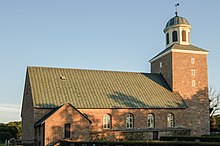Köpingsvik
| Köpingsvik | ||||
|
||||
| State : | Sweden | |||
| Province (län): | Kalmar Lan | |||
| Historical Province (landskap): | Öland | |||
| Municipality : | Borgholm | |||
| Coordinates : | 56 ° 53 ' N , 16 ° 43' E | |||
Köpingsvik is a district of Borgholm on the Swedish island of Öland . It belongs to the municipality of Borgholm in the province of Kalmar Lan and is located about four kilometers east of the center of Borgholm. Köpingsvik is known for its large campsites .
Until 2010, Köpingsvik was an independent crime scene with 599 inhabitants. After that, like Björkviken, which is located between Köpingsvik and Borgholm, it was added to the Borgholm crime scene, as the area of the three villages is now practically continuously built up.
archeology
In connection with the construction of the Öland Bridge , the country roads on Öland were also expanded in the early 1970s, and a prehistoric settlement was discovered in Köpingsvik that was four times the size of Birka and twice the size of Haithabu , comparable to the Dutch Dorestad or Jomsburg in Poland.
Ship graves have been discovered a little north of the village at the highest point in Öland . In one of the tombs from the 10th century, the cremated remains of a man and a woman have been excavated. There was also a bronze jug made of Samarqand or Buxoro and various animal bones in the grave , with the humerus of a polar bear attracting the most attention. One of the iron spears found resembles the spears found in Sutton Hoo's tomb . Not far from the boat graves, Blå rör is one of Sweden's largest cairn graves ( Röse ).
To the southeast of Köpingsvik is Skedemosse , where the remains of people and horses have been found. One of Sweden's greatest weapons victims was excavated in the former marshland. At Löt, east of Köpingsvik, are the remains of a prehistoric defense system.
A large number of rune stones found in the area are exhibited in the church of Köping . South-east of the church is Tingsflisan , one of the largest rune stones on Öland. To the west of Köpingsvik is the Köpings klint rock formation on which the cemetery on the Köpings klint is located. The Sankt-Elof-Quelle rises below the cliff , where a so-called sacrificial heap is located.
Web links
Individual evidence
- ↑ Befolkning i tatorter 1960–2010 on the website of Statistiska centralbyrån (Excel file)

